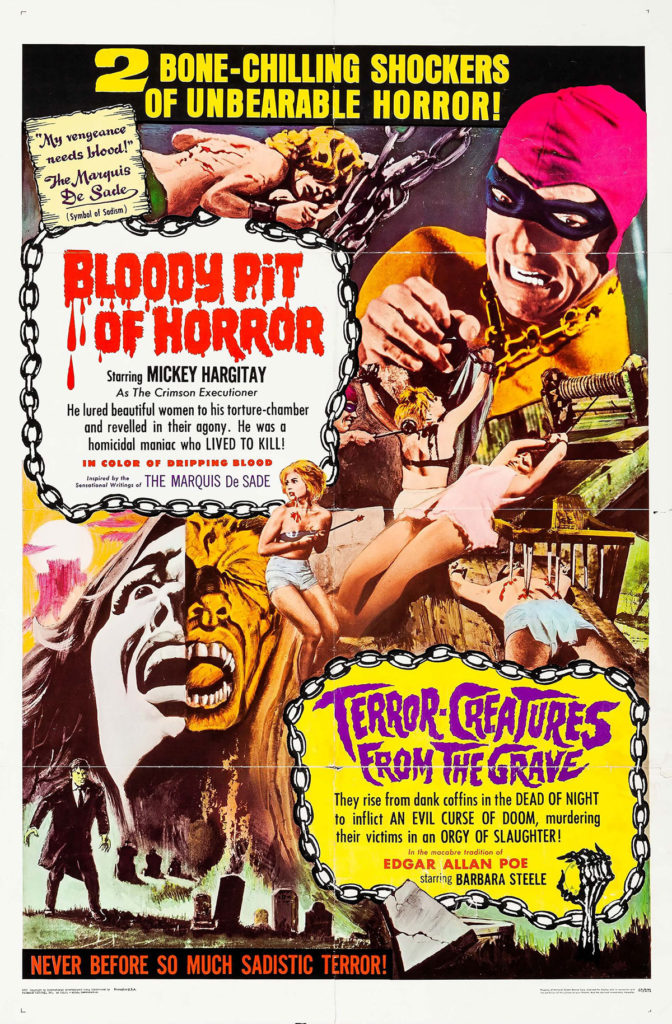 Pacemaker Pictures, the English-language distributors of Terror-Creatures from the Grave, the 1965 Italian gothic horror flick, sure went all in on the title. Perhaps they had a shortlist and couldn’t decide between Terror from the Grave and Creatures from the Grave so, like some parents, decided to burden their charge with a hyphenated name. It’s a mouthful, but has loads of kitsch to it.
Pacemaker Pictures, the English-language distributors of Terror-Creatures from the Grave, the 1965 Italian gothic horror flick, sure went all in on the title. Perhaps they had a shortlist and couldn’t decide between Terror from the Grave and Creatures from the Grave so, like some parents, decided to burden their charge with a hyphenated name. It’s a mouthful, but has loads of kitsch to it.
Directed by Massimo Pupillo, from a screenplay by Romano Migliorini and Roberto Natale, Terror-Creatures is plays like a pageant in honor of horror cinema. Shot in stark black and white by Carlo Di Palma, the film relies heavily on early horror film styles and storytelling, while combining it with contemporary trends in Italian cinema. There’s the dark and stormy night, overlayered with endless theremin music, combined with dramatic closeups and the multinational cast mouthing their lines in different languages. It’s like watching an old Universal horror film, and everyone is poorly dubbed. Unfortunately, that dubbing can be somewhat distracting, but Pupillo and company nevertheless made a decent horror film.
The film takes place in the early 20th century. A lawyer, Albert Kovac (Walter Brandi), arrives at a rural estate called the Villa Hauff. His firm received a letter from a client, asking that another lawyer, Joseph Morgan, be dispatched at once to oversee the final will and testament of Dr. Jeronimus Hauff, a scientist. Morgan wasn’t available, and that is why Kovac is there.
After he arrives at the villa, viewers meet Dr. Hauff’s daughter, Corinne (Mirella Maravidi), and second wife, Cleo (Barbara Steele). They read the letter, which appears authentic, in shock, as it has been almost a year to the day since Dr. Hauff died from a broken neck. Afterwards, Corinne begins seeing visions of her father, but his specter always disappears before anyone else sees him (including the viewer). Meanwhile, Kovac is staying at the villa in Dr. Hauff’s former chambers, and discovers a series of phonographs, narrated by Dr. Hauff, detailing his experiments in the supernatural.
Later, in the local village, Kovac teams up with physician Dr. Nemek (Alfredo Rizzo), to solve the mystery of the letter. More people testify to its authenticity. Kovac also learns that those who witnessed Dr. Hauff tumble to his death, and signed his death certificate, have all been dying in horrible fashion. Only two remain, Oscar Stinnel, and Joseph Morgan, who appears late in the film and is played by Riccardo Garrone.
Pupillo showed deft storytelling skill. There were many different ways this plot could have been resolved, and Pupillo touched on as many of them as he could. It makes for a fair amount of misdirection, yet it never feels forced. A little overcomplicated at times, sure, but for much of the film, a viewer will be unsure whether or not all the strange occurrences and deaths are the result of the supernatural, or something more corporeal. It all leads to a very predictable, and also very satisfying, ending.
While the storytelling is good, it’s hard to speak on the acting. The dubbing really is a problem. For one, Barbara Steele, while no Meryl Streep, is a much better actress than whoever did her dubbing. Some of the other voice actors have the same tone and precision as a radio advertisement.
I picked on composer Aldo Piga’s overuse of the theremin earlier on. By 1965 using a theremin in a horror flick in anything other than an ironic way was quite gauche, but the rest of the score, which was orchestral, was very good and fit the film well. It’s good enough that bits and pieces of it sound like they were cribbed by John Williams, Elmer Bernstein, and Brian May (the other one) for one or two of their film scores. Let’s call it ‘coincidental homaging.’
This horror film has fallen through the cracks, like so many others. But this is an earnest production. Get past all of the foibles of low rent Italian cinema, and Terror-Creatures is as good as any of Hammer’s finer efforts.
